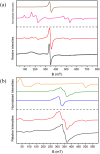Templating metallocycles with a macrocycle: synthesis, structures and magnetic studies of {Cr11M2} complexes
- PMID: 36477464
- PMCID: PMC9764323
- DOI: 10.1039/d2dt03368b
Templating metallocycles with a macrocycle: synthesis, structures and magnetic studies of {Cr11M2} complexes
Abstract
Addition of 1,4,8,11-tetrazacyclotetradecane (cyclam) to a reaction that produces octametallic rings when simpler amines are used, produces {Cr11M2} "pretzels" (M = ZnII or CuII) where the cyclam coordinates to the MII ion which then sits at the centre of a twelve-metal macrocycle. Magnetic studies were fitted using the finite-temperature Lanczos method (FTLM), and the results demonstrate that exchange interactions are transferable from previous exchange-coupled CrIII rings.
Conflict of interest statement
There are no conflicts to declare.
Figures





Similar articles
-
Cyano-bridged bimetallic assemblies from hexacyanometalate, [M(CN)6](3-) (M = Mn(III) and Fe(III)), and [M(N4-macrocycle)]2+ (M=Fe(III), Ni(II) and Zn(II)) building blocks. Syntheses, multidimensional structures, and magnetic properties.Inorg Chem. 2001 Sep 10;40(19):4876-83. doi: 10.1021/ic0103446. Inorg Chem. 2001. PMID: 11531434
-
Tris(pyridinealdoximato)metal complexes as ligands for the synthesis of asymmetric heterodinuclear Cr(III)M species [M = Zn(II), Cu(II), Ni(II), Fe(II), Mn(II), Cr(II), Co(III)]: a magneto-structural study.Inorg Chem. 2001 Dec 17;40(26):6656-65. doi: 10.1021/ic010552y. Inorg Chem. 2001. PMID: 11735476
-
Selective recognition of configurational substates of zinc cyclam by carboxylates: implications for the design and mechanism of action of anti-HIV agents.Chemistry. 2003 Oct 6;9(19):4709-17. doi: 10.1002/chem.200304808. Chemistry. 2003. PMID: 14566877
-
Heterodinuclear metal arrangement in a flat macrocycle with two chemically-equivalent metal chelating sites.Inorg Chem. 2012 Feb 6;51(3):1508-15. doi: 10.1021/ic201803c. Epub 2012 Jan 10. Inorg Chem. 2012. PMID: 22233424
-
Heterometallic Rings: Their Physics and use as Supramolecular Building Blocks.Angew Chem Int Ed Engl. 2015 Nov 23;54(48):14244-69. doi: 10.1002/anie.201502730. Epub 2015 Oct 13. Angew Chem Int Ed Engl. 2015. PMID: 26459810 Review.
Cited by
-
Hybrid Inorganic-Organic Rotaxanes and Related Compounds.Chemistry. 2025 Jun 26;31(36):e202501067. doi: 10.1002/chem.202501067. Epub 2025 May 30. Chemistry. 2025. PMID: 40386965 Free PMC article. Review.
References
-
- Pilkington N. H. Robson R. Aust. J. Chem. 1970;23:2225–2236.
-
- Saalfrank R. W. Bernt I. Uller E. Hampel F. Angew. Chem., Int. Ed. Engl. 1997;36:2482–2485. doi: 10.1002/anie.199724821. - DOI
LinkOut - more resources
Full Text Sources

